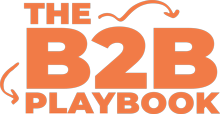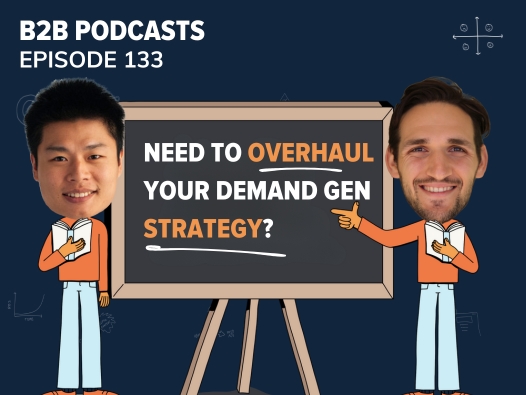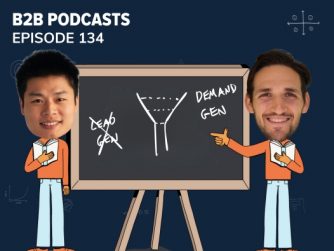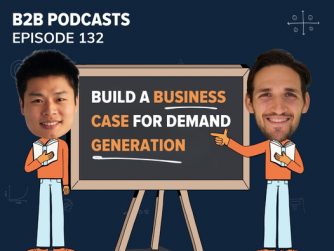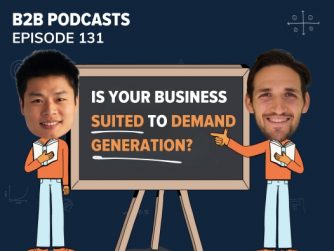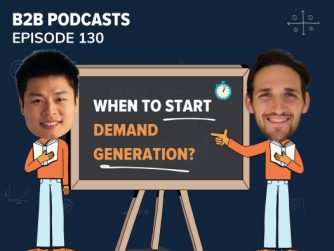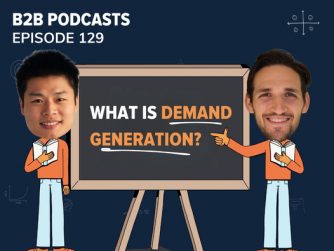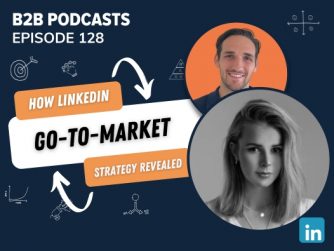Every marketer faces this dilemma – should you overhaul your demand generation strategy, or simply enhance what you already have?
So many marketers have a ridiculous amount to do, so we’re not going to make you throw the baby out with the bath water if you don’t have to. In our experience working with businesses to help them implement demand gen programs, and teaching marketers how to do it inhouse – very often the marketer is doing some activities that can double as demand gen activities.
That’s why today, we’re going to give you 10 critical questions to work through to give you clarity on whether to start fresh, or just plug the gaps in your existing demand gen strategy.
This is part of our Demand Gen mini-series. You can access previous whiteboarding sessions here:
- What is demand generation? (part 1)
- When is the right time to start demand generation? (part 2)
- What companies are suited to demand generation? (part 3)
- How to build a winning business case for demand generation? (part 4)
As per usual, you can read, watch or listen below to work through these 10 questions and see if you need to totally revise your Demand Gen plan, or just work with what you’ve got!
Listen To The Episode
Watch The Episode
Q1: Are Marketing and Sales Aligned on your Best Customers and Target Market?
Aligning sales and marketing on your ideal customer profile and target segment lays the critical foundation for an effective demand generation strategy. Every single business has a limited amount of resources, budget and time. We know that to build trust with a potential buyer takes multiple touchpoints. Each touch point is a drain on your resources.
Demand Generation is about dedicating the limited resources you have to capturing demand and creating demand.
Because our resources are limited, we need to focus on winning over the most important segment(s) or our business. If you are trying to win over every industry and every type of client, chances are you won’t have an impact.
“We don’t have unlimited resources, no business does, so we can’t go after the whole market at once. That’s why it’s incredibly important to consider. Have you and sales actually sat down and aligned on who it is that you guys are targeting?”
George Coudounaris – The B2B Playbook – [00:06:30]
Why? Because we just don’t get in front of businesses enough times to earn their trust and win them as a client when they come in-market. It also means that your marketing won’t be targeted enough – you won’t have a deep understanding of their pain points, your marketing will be confusing because it will be speaking to too many people.
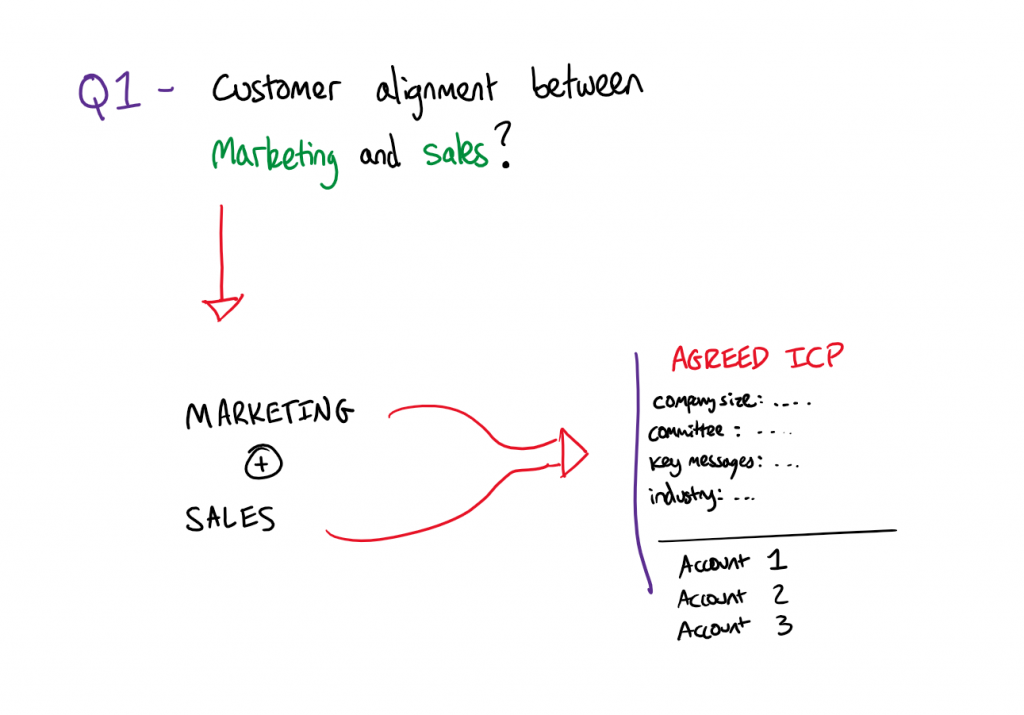
The consequences play out in missed opportunities across the buyer’s journey. For example, your content may thoroughly explore solutions but neglect stoking problem awareness.
If you haven’t sat down with sales and identified who your best-fit customers are, and noted firmographic ally where your next best opportunities are coming from – there’s a good chance you need to start your demand generation strategy again from scratch.
These are the foundations for the rest of your Demand Gen program. So if it’s not based on a deep understanding of your best customers, you probably need to go back to the beginning and start again.
Q2: Is Your Understanding of Customer Needs Informed By Interviews?
If you do have a segment of the market you’re focussing on – that’s great. But where we see so many marketers go wrong is they get their market intel from their competitors, surveys – or even worse – hypothesise what’s important to them, and A/B test pain points and messages.
If you’re going to build a demand generation program that builds trust and makes people want to buy from you, you need to find out: their needs, pain points, jobs to be done, greatest benefits of your product, where they hang out online and offline, what the buying committee looks like, what their customer journey looks like – and more.
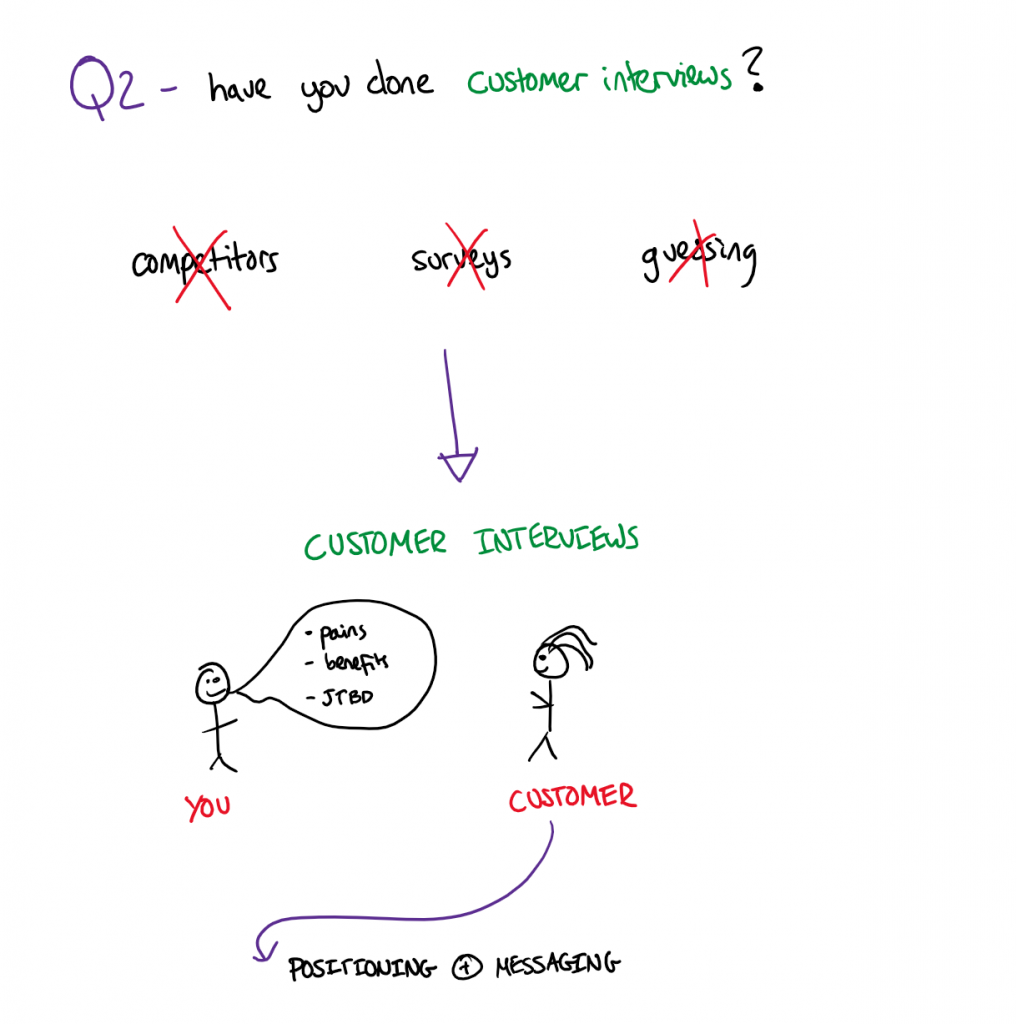
BUT, there’s no substitute for getting these insights directly from the customer via customer interviews. Without this, you’re guessing what these pains are. Not only will you get exactly what those pain points and benefits are, you’ll also importantly get the language that they’re using so that you can feed that straight into your positioning and messaging.
If you haven’t done this, and have build your Demand Gen program on a lot of assumptions – you likely need to go back and do this and start again. It’s a very important foundation.
Otherwise, how else will your content resonate with them?
Q3: Are Your Content Pillars Reflective of Customer Interview Insights?
Once you’ve captured the voice of the customer through interviews, the next step is mapping those insights directly to your content pillars.
Our content pillars are what helps us build trust with our Dream Customers, and also what leads them to the logical conclusion that we’re the perfect solution to the problem they’re having. So it’s very important these are based on real problems our Dream Customers are having.
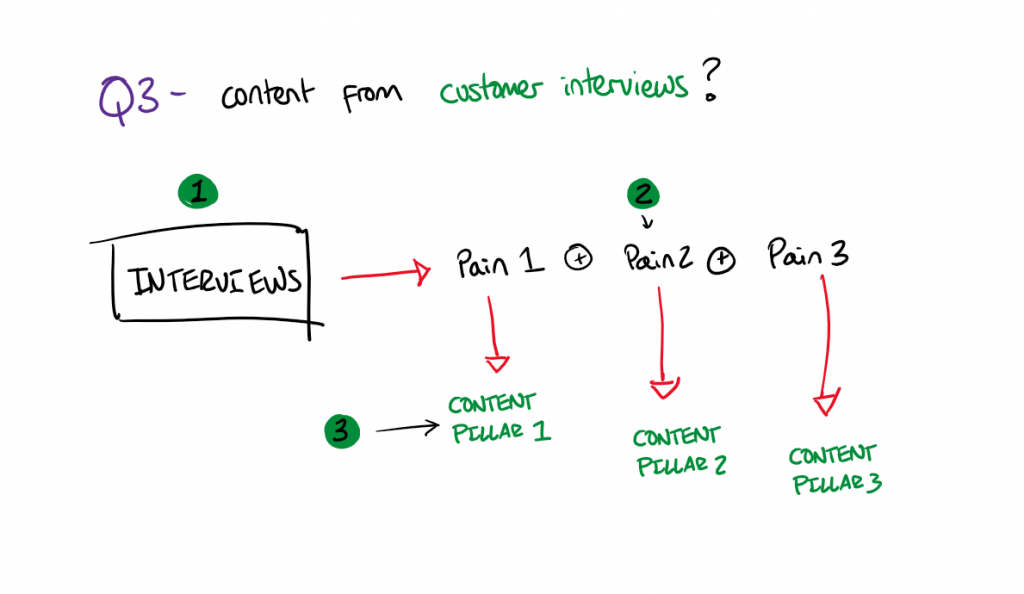
Too often, I see marketers basing their content pillars on flawed sources like what your competitors are doing, market analysis or guesses based on quantitative data analysis.
While those sources can play a supplementary role to confirm certain suspicions and fill gaps, the content pillars needed to be grounded in what the customer really wants. Master the customer voice, map it to your content pillars, and you’ll be armed with a demand gen content engine primed to deliver real results.
If you don’t know what these pain points are and your content pillars are based on what your competitors are doing or guesses – you probably need to start again.
Q4: Is Your Content Led By Subject Matter Experts?
Your buyers are smart. If you have a freelancer faking expertise in their content, they will sniff it out a mile away. For example, let’s say you’re a marketer that’s selling a product to engineers. If you have a freelancer pretending to have technical expertise, that content will not help build trust that that prospective customer.
In fact, often it will do the opposite. It doesn’t address your audience’s needs, and it hurts your credibility.
Subject Matter Experts (SME) are people with real experience and real understanding of the problems your Dream Customers are having. They can speak as technically as your buyer. In the example above, it’s someone who can talk to the level required by the engineers you’re selling to (often and engineer themselves). Rarely do they exist in the marketing department.
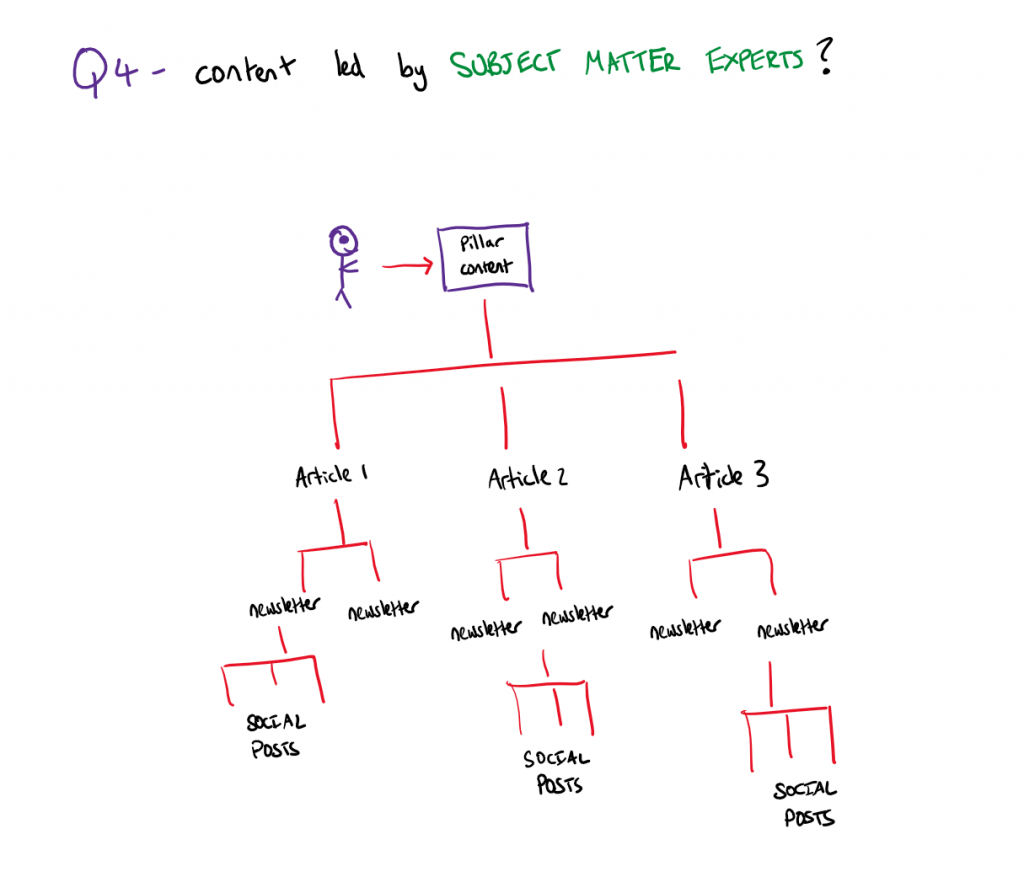
You SMEs need to be at the forefront of content creation. Have them author your pillar pieces that explore and solve those critical customer challenges. Your SME can be the person that writes or films that pillar piece of content. Then your marketing team’s role becomes repurposing and amplifying that definitive content through articles, social, and more channels your prospects frequent.
In our case, we love doing it in a podcast format because you capture video and audio, and then. repurpose those into articles, newsletters, social posts.
If you don’t have a SME leading your content, that’s okay – no need to start your Demand Gen strategy from scratch. Instead, source one internally or externally to the business, make sure they understand the pain points of your Dream Customers, and start involving them in the creation of your pillar pieces of content
Q5: Is Your Content Matched to the Five Stages of Awareness?
Your content needs to guide prospects through the entire buying journey: from being unaware that they have a problem, all the way through to being led to the logical conclusion that you’re the perfect company to help them solve it. The 5 Stages of Awareness is our favourite content framework because it gets you to map your content to these different stages of the buying journey.
Those five distinct stages are unaware, problem aware, solution aware, product aware, and most aware. Each represents a different level of consciousness and intent from your prospects. You can read more about The 5 Stages of Awareness Framework here.
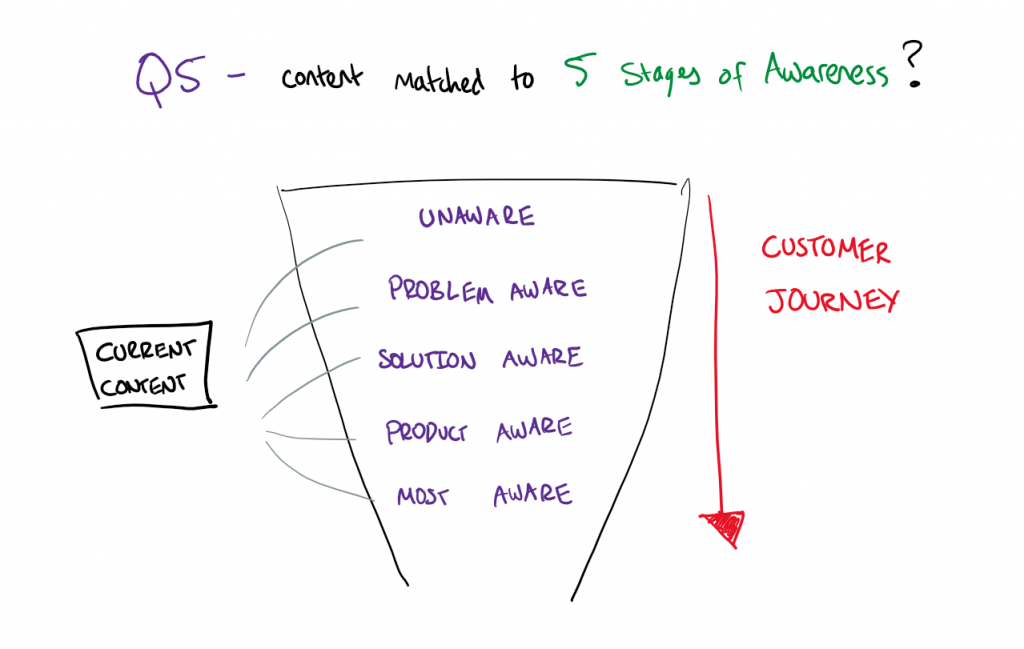
It’s important to make all 5 stages of content available to your Dream Customers as they bounce around between different stages of awareness. What feels incredibly problematic today, might slip down the priority list tomorrow.
The beauty is that this framework provides a clear roadmap for auditing any gaps in your existing content strategy. Go through, match your content in there, see where the gaps are. And go through and fill them. By mapping all your content assets to this five stage model, you’ll ensure you have the right customer education and enablement pieces to nurture demand from initial awareness all the way through to closed deals.
If your content isn’t matched to this framework – that’s okay, there’s no need to start again. Go back and get your existing content (e.g. articles, podcasts, whitepapers, webinars) and match it to the different stages. Fill the gaps where they exist.
Q6: Do You Have a Content Repurposing and Distribution System?
Creating great content is just the first step – you then need a robust repurposing and distribution system to maximize that content’s impact. As Kevin points out,
“For demand gen to work, your content needs to feature subject matter experts and it needs to be put in front of your dream customers”
Kevin Chen – The B2B Playbook – [00:18:50]
The challenge is that those subject matter experts’ time is extremely limited. So rather than having them involved in pushing out every single content piece, a better strategy is to get them to help you record and create that pillar piece of content, and then have a repurposing system to turn this one core piece of pillar content into many more pieces of content that you can use over time..
We practice what we preach with this content repurposing approach. We do this one video podcast once a week (our pillar content) and we get 12 LinkedIn posts, three articles, one newsletter, and up to 12 YouTube shorts, and even tiktoks.
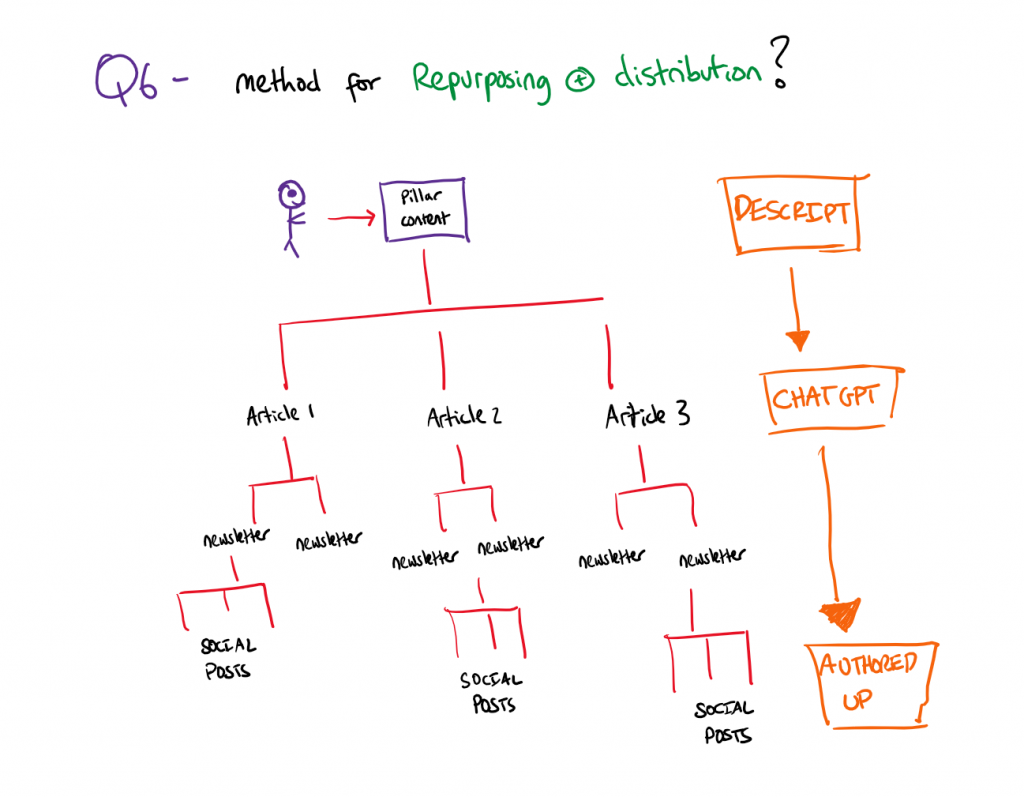
But repurposing is only half the battle. You need a consistent cadence for distributing that Content through the right channels. Make sure you have a content calendar in place. That way, you’ll know exactly what is being posted and where, and what you potentially might be missing.
Consistency is the key to demand generation. Repurposing and consistent distribution is what enables this.
If you don’t have this system in place, that’s okay. Go back and document your system for turning pillar content into smaller pieces of content. Consistency is key!
Q7: Are you Tracking Leading and Lagging Demand Gen Indicators to Measure Success?
Simply publishing content isn’t enough – you need a comprehensive demand gen KPI and measurement strategy to understand what’s working and what needs refinement in your demand generation efforts.
We like to split up our leading and lagging indicators into our three tiers of measurement. This tiered approach allows you to track performance and make optimizations at multiple levels.
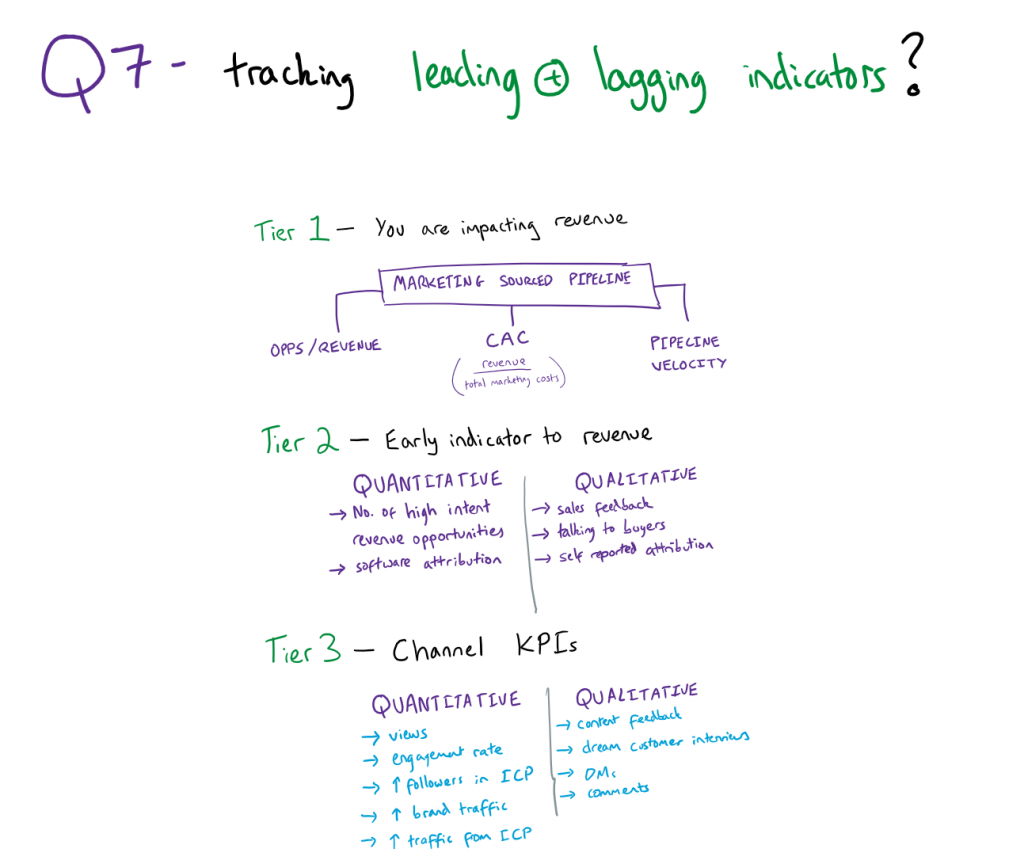
Tier 3 focuses on channel metrics like engagement on your social posts, article views, and other content consumption data points. It’s really looking at like our channel level KPIs. So we can check that what we’re doing on social and articles is that starting to show signs of life.
Tier 2 represents early indicators that your content is translating into revenue potential – things like high-intent sales opportunities, and sales team feedback on content influence.
But the ultimate goal is Tier 1 – quantifying the direct impact your demand generation program is having on the business’s bottom line. We look at the revenue that we’re driving, we look at our cost per acquisition, and we look at the pipeline velocity as well.
Check out our Complete Guide to Measuring Demand Generation and KPIs here.
If you have an existing Demand Gen program in place, make sure you measure first the leading/lagging indicators of success before changing tact. What you’re doing might already be working. So check this before starting again!
Q8: Have You Tried Account-Based Marketing (ABM)?
Once you have your core demand generation engine humming, it’s time to supplement it with an account-based marketing (ABM) strategy for your highest-value prospects.
ABM allows you to double down on specific high-potential accounts through hyper-personalized campaigns.
The rationale for ABM is clear:
“Because the figures are so big for that one transaction, you actually need some extra work to get them across the line. And that’s where account-based marketing really becomes important”
George Coudounaris – The B2B Playbook – [00:23:50]
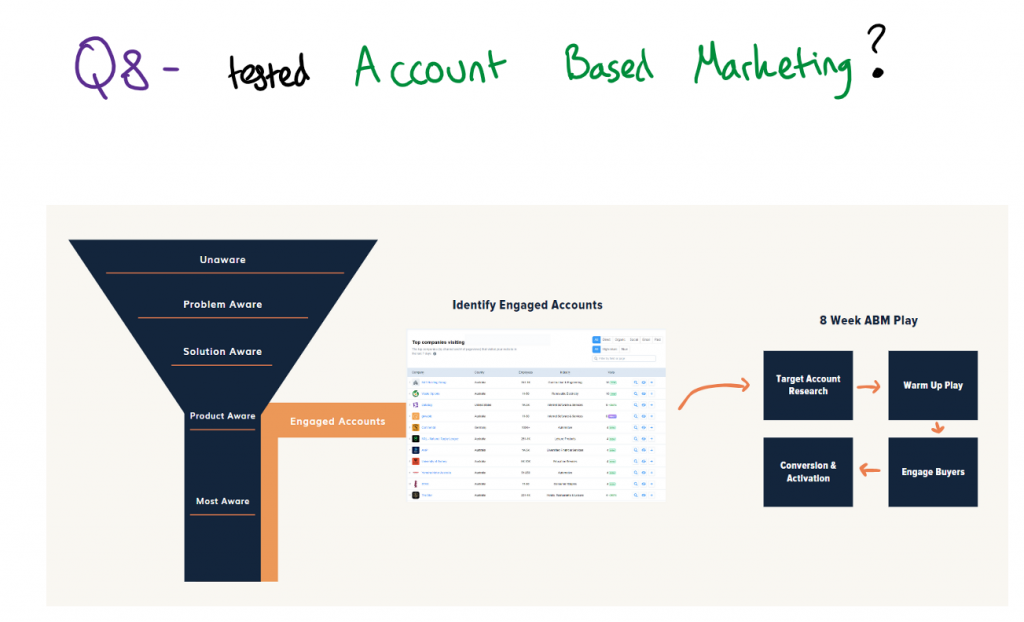
ABM requires tightly aligning your marketing and sales efforts around a defined list of target accounts. This involves identifying accounts that are expressing some intent, and then creating a strategy between marketing and sales to take high-touch, deliberate actions to work together to warm up those accounts, and then to activate them into paying accounts.
The good news is that adding an ABM motion doesn’t require rebuilding your entire demand gen program from scratch. If you’ve done all the legwork before in setting up the foundations and getting a demand generation engine going, you’ve got all that helpful content going already. Account-based marketing should be quite easy to put on top.
So for those high-value, considered purchases, layer on an ABM pilot once your core demand engine is established. Used together, these two motions provide comprehensive demand capture and conversion.
Q9: Are Product Ads Highlighting Customer-Centric Messaging?
Your content and messaging needs to be customer-centric through and through – and that applies just as much to your product advertising as your educational content pieces.
Product ads help educate on the benefits and features of your product. They’re very important in addition to the content you’ve created on The 5 Stages of Awareness.
Make sure that when you do create these ads, you’re promoting your main benefits and features as your customer sees it. Don’t just promote your product or service through your own internal lens and vocabulary. Speak directly to how your ideal customers view and describe their problems and desired solutions.
And of course, social proof from existing customers is crucial for lowering buying friction.
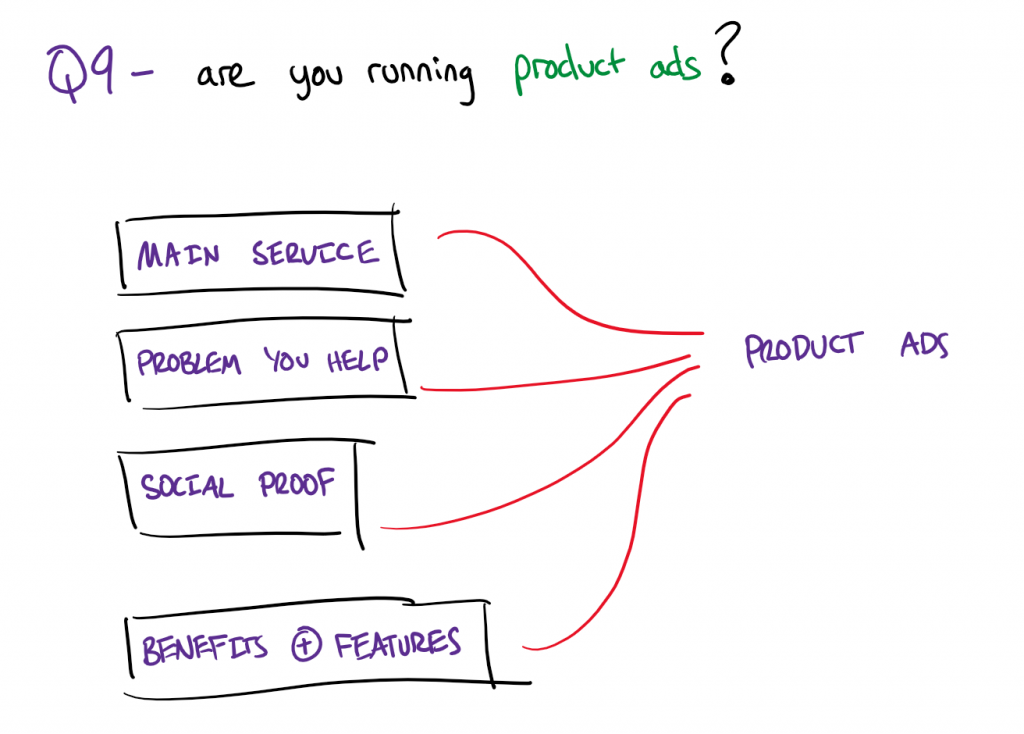
Make your product messaging customer-centric by grounding it in the actual words and sentiments captured in those customer interviews.
If you haven’t created product ads yet – that’s okay! You don’t have to start your demand generation program again from scratch. Grab the insights you need from the customer, and create these now to complement your helpful content.
Q10: Is Your Demand Generation Strategy Documented?
You’ve put in the hard work – conducting customer interviews, mapping insights to content pillars, distributing content consistently across channels, measuring performance, and more. But without a documented demand generation strategy, all those efforts risk getting siloed or losing focus over time.
So many marketers are caught up in the day-to-day. They’ve been executing so many different tactics, but haven’t tied it together in a documented, cohesive strategy. That documented plan is the connective tissue tying everything together.
I can’t overstate the benefits of taking the time to formally document your demand gen strategy and roadmap. It can be easily shared with sales, leadership, new members of the team to really help with alignment and make sure that there’s no further alignment issues coming up in the future because everyone can have this one document to refer back to.
Better yet, documentation enables you to outsourcing components of execution as you scale.
We bake this critical step into our own B2B Incubator program to help businesses get started with demand generation. It documents that process and you go away after the end of the incubator program with that documentation in place, for the lifetime of your business.
So take the time to document every component – from goals and target audiences to content strategy, measurement, roles and more. That record serves as the demand gen bible to maximise your chances of success.
Ready To Build Your Demand Gen Plan & Engine?
Create Your Demand Engine in 12 Weeks
B2B marketing strategy that shows you step-by-step how to drive revenue
